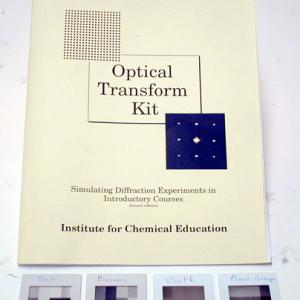College of Liberal Arts & Sciences
7A60.21 - Electron Diffraction - Optical Simulation
See also 6D20.58 in Optics
An optical analog of electron diffraction is to use the slides that have crystal pattern reductions and a laser. Different crystal structures will give different 2-D diffraction patterns.
- Athanasios Velentzas, "Teaching Diffraction of Light and Electrons: Classroom Analogies to Classic Experiments", TPT, Vol. 52, # 8, Nov. 2014, p. 493.
- Se-yuen Mak, "Grating for Simulation of Laue Crystal Diffraction", TPT, Vol. 32, # 9, Dec. 1994, p. 539.
- H. H. Barschall, "The Optical Model of the Nucleus", TPT, Vol. 7, # 9, Dec. 1969, p. 481.
- N. Ferralis, A. W. Szmodis, and R. D. Diehl, "Diffraction from One- and Two-Dimensional Quasicrystalline Gratings", AJP, Vol. 72, # 9, Sept. 2004, p. 1241.
- Heidi Jo Marvin, "Fraunhofer Diffraction By Diamond-Shaped Apertures: A Theoretical and Experimental Study", AJP, Vol. 56, # 6, June 1988, p. 551.
- Kathryn D. Burch et al., "Optical Simulation of Low-Energy Electron Diffraction Patterns", AJP, p. 237, Vol. 53, No. 3, March 1985.
- George R. Mitchell, "The Reciprocal Lattice - A Demonstration", AJP, Vol. 46, #5, May 1978, p. 574.
- Ronald Bergsten, "Optical Crystals", AJP, Vol. 42, # 2, Feb. 1974, p. 91.
- E. Hecht, "Symmetries in Fraunhofer Diffraction", AJP, Vol. 40, # 4, Apr. 1972, p. 571.
- D. De Fontaine, K. A. Jackson, C. E. Miller, "Optical Diffraction from a Two-Dimensional Array of Spheres", AJP, Vol. 37, #8, Aug. 1969, p. 789.
- T. Grattan and K. Jamison, "Optical Electron Diffraction Can Be Demonstrated With Homemade Kit", Physics Education, Vol. 39, # 4, July 2004, p. 320.
- "Optical Transform Kit", Institute for Chemical Education, University of Wisconsin - Madison.
- Ellis, Geselbracht et al., Teaching General Chemistry: A Materials Science Companion, "Chapter 4: Determination of Structure Using Data", p. 77.
Disclaimer: These demonstrations are provided only for illustrative use by persons affiliated with The University of Iowa and only under the direction of a trained instructor or physicist. The University of Iowa is not responsible for demonstrations performed by those using their own equipment or who choose to use this reference material for their own purpose. The demonstrations included here are within the public domain and can be found in materials contained in libraries, bookstores, and through electronic sources. Performing all or any portion of any of these demonstrations, with or without revisions not depicted here entails inherent risks. These risks include, without limitation, bodily injury (and possibly death), including risks to health that may be temporary or permanent and that may exacerbate a pre-existing medical condition; and property loss or damage. Anyone performing any part of these demonstrations, even with revisions, knowingly and voluntarily assumes all risks associated with them.
